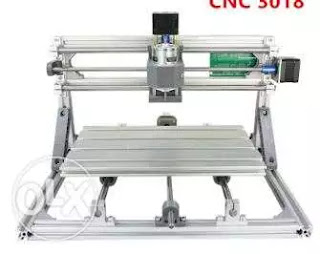Mini Desktop Cnc Machine Availabe at olx:
CNC 2632:
CNC 3018:CNC 3060:
A CNC router typically produces consistent and high-quality work and improves factory productivity. Unlike a jig router, the CNC router can produce a one-off as effectively as repeated identical production. Automation and precision are the key benefits of cnc router tables.
A CNC router can reduce waste, frequency of errors, and the time the finished product takes to get to market.
A CNC router can be used in the production of many different items, such as door carvings, interior and exterior decorations, wood panels, sign boards, wooden frames, moldings, musical instruments, furniture, and so on. In addition, the CNC router helps in the thermoforming of plastics by automating the trimming process. CNC routers can help ensure part repeatability and sufficient factory output.
Depending on what type of machine you have, determines what process you have to take to get the CNC machine running. Typically you have to upload a picture or file into a drawing software (CAD) and then have it converted to vectors [if you don’t have a file or picture, you can also use a drawing software to create your own image or drawing]. After uploading the file and tracing the file with vectors, now you are ready to select the tool and toolpath that you want the machine to make. This is where you have a lot of control over the system. First, you want to select the tool that you want to use, whether it be a .25 inch v-bit or a .75 inch core box bit. This is also where you have the option of changing the speed of the router along with the cut depth. After selecting the tool, you have to select the toolpath that you want to use. In most cases, you can either trace the vectors, cut outside the vectors, or cut inside the vectors. This is up to the discretion of the machinist depending on what they need. After selecting the toolpath, then it’s time to upload the vectors into a g-code software [typically this is the control panel of the CNC router itself]. By doing this task, you will convert the vectors into a scripts of G-code. In this G-code, you will see coordinates for X, Y, and Z [X being horizontal to the table, Y being vertical to the table, and Z being perpendicular to the table]. After having the vectors converted to G-code, you then need to determine where the center point of the part is [doing this is very key in the next few steps]. After finding the center of the part, you then load the part onto the table and secure it with clamps [it’s very important that the part doesn’t move during this cutting process]. After securing the part to the table, you then need to jog the machine over until the router bit is directly above the center point that you marked. Once you have it properly aligned, you need to jog the machine down until the router bit is on the face of the part [make sure not to dig into the part with the bit]. Once this step is complete, you need to mark this point as your absolute zero. Doing this will create the start point once the machine is up and running. Once the absolute zero point is set, jog the machine up a few inches and you’re ready to begin. Once you’re off the part, select the run G-code function and the machine will begin to cut your design.


